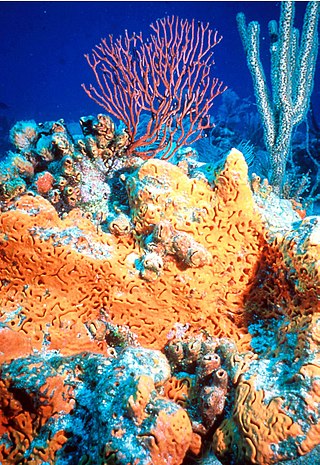
Sponges, the members of the phylum Porifera, are a basal animal clade as a sister of the diploblasts. They are multicellular organisms that have bodies full of pores and channels allowing water to circulate through them, consisting of jelly-like mesohyl sandwiched between two thin layers of cells.

Agelas clathrodes, also known as the orange elephant ear sponge, is a species of sea sponge. It lives on reefs in the Caribbean, usually more than 10 metres (33 ft) below the surface of the ocean. It takes various forms, and its color is reddish orange.
Arturia canariensis, commonly known as the yellow calcareous sponge, is a species of sponge in the family Clathrinidae. It is found in shallow seas in the Canary Islands, Cape Verde, the Adriatic Sea and the Caribbean Sea. The specific epithet "canariensis" was given to this species because it was first described from Lanzarote in the Canary Islands.

Oreaster reticulatus, commonly known as the red cushion sea star or the West Indian sea star, is a species of marine invertebrate, a starfish in the family Oreasteridae. It is found in shallow water in the western Atlantic Ocean and the Caribbean Sea.

Ircinia strobilina is a species of sponge in the family Irciniidae. It is grey or shiny black in colour, with spiny structures (conules) dotting the surface. The spiny structures are interconnected by ridges, though not arranged in an orderly lattice. This species is globular and massive in shape, but usually no more than 0.3 metres (1 ft) across. I. strobilina is lobed and spherical and has a tough consistency. The large excurrent pores are located in depressions at the top of the sponge. Many smaller incurrent pores are scattered across the surface, more densely at the sides.

Amphimedon compressa, the erect rope sponge, red tree sponge, red tubular sponge, or red sponge is a demosponge found in southern Florida, the Caribbean Sea, and the Bahamas. It can be deep red, orange, brown, or black.

Callyspongia (Cladochalina) aculeata, commonly known as the branching vase sponge is a species of sea sponge in the family Callyspongiidae. Poriferans are typically characterized by ostia, pores that filter out plankton, with an osculum as the opening which water leaves through, and choanocytes trap food particles.

Eusmilia is a genus of stony coral in the family Meandrinidae. It is a monotypic genus represented by the species Eusmilia fastigiata, commonly known as the smooth flower coral. It is found on reefs in the Caribbean Sea.

Umimayanthus parasiticus, commonly known as the sponge zoanthid, is a species of coral in the order Zoantharia which grows symbiotically on several species of sponge. It is found in shallow waters in the Caribbean Sea and the Gulf of Mexico.

Agelas is a genus of sea sponge in the class Demospongiae.

Parazoanthus swiftii, commonly known as the golden zoanthid, is a species of coral in the order Zoantharia which grows symbiotically on several species of sponge. It is found in shallow waters in the Caribbean Sea and western Atlantic Ocean.
Iotrochota birotulata, commonly known as the green finger sponge, is a species of sea sponge in the family Iotrochotidae. It is found in shallow waters in the Caribbean Sea.
Neofibularia nolitangere, commonly known as the touch-me-not sponge, is a species of sea sponge in the family Biemnidae. It is found in shallow waters in the Western Atlantic Ocean and the Caribbean Sea.
Aplysina insularis, commonly known as the yellow-green candle sponge or yellow candle sponge, is a species of sea sponge found on reefs in the Caribbean Sea and the Gulf of Mexico.

Dichocoenia is a monotypic genus of stony coral in the family Meandrinidae. It is represented by a single species, Dichocoenia stokesii, which is commonly known as pineapple coral, elliptical star coral, or pancake star coral. It is mostly found in the Caribbean Sea and the western Atlantic Ocean. Dichocoenia stokesii has irregular calyces and its form can be either a massive, hemispherical hump or a flat, platform-like structure.
Agelas flabelliformis, also known as the elephant ear sponge, is a species of demosponge. It takes the form of a large leathery slender flap and is found in the Caribbean area at depths down to 100 metres (330 ft).

Mycale laevis, the orange icing sponge or orange undercoat sponge, is a species of marine demosponge in the family Mycalidae. Mycale is a large genus and this species is placed in the subgenus Mycale making its full name, Mycale (Mycale) laevis. This sponge is found in the Caribbean Sea and the Gulf of Mexico and usually grows in association with one of a small number of species of coral.

Agelas tubulata is a species of demosponge. It is tube-shaped or vase-shaped and variable in colour. It is found in the Caribbean area and along the coasts of Brazil at depths of between about 70 and 90 m. It was first described by Lehnert & Rob van Soest in 1996, the type location being the Greater Antilles.
Agelas dispar is a species of demosponge in the family Agelasidae. It lives on shallow-water reefs in the Caribbean Sea and around the West Indies.











